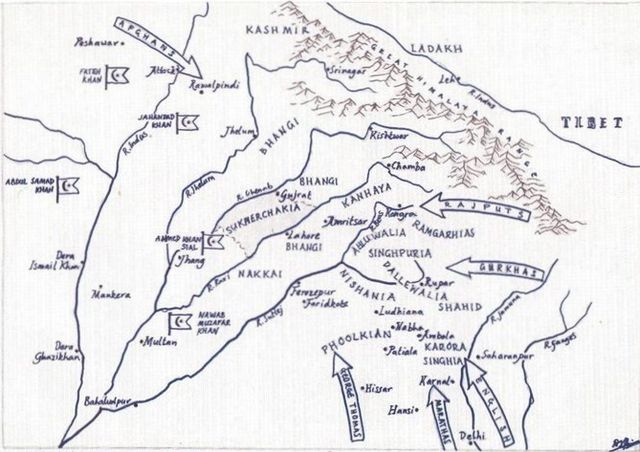Kanhaiya Misl
Contributors to Wikimedia projects
 Article Images
Article Images
"Kanhaiya Misl", was a prominent Sikh confederacy that emerged in 18th-century Punjab, India, founded by Jai Singh Kanhaiya, a Sandhu Jat from Kanha Kachha village, 21 kilometers east of Lahore, in 1733. The misl rose to prominence under Jai Singh's leadership, The Kanhaiya Misl's territorial dominion spanned across five key districts in Punjab, encompassing Amritsar, Gurdaspur, Hoshiarpur Kangra, and Sialkot[1]
History
Amar Singh Kingra led a band of around 100 Sikh youths, with Jai Singh, a Sandhu Jat from Kanha Kachha village, 21 kilometers east of Lahore, serving as his trusted deputy. Jai Singh's father, Khushhal Singh, made a living selling grass and wood in Lahore, but Jai Singh yearned for more, inspired by the daring exploits of the Sikhs. He took the sacred vows of Sikhism, known as pahul, from Nawab Kapur Singh and joined Amar Singh Kingra's band[2]
Jai Singh's nickname, Kanha or Kanhiya, stemmed from his village's name, his handsome appearance, reminiscent of Krishna Kanhiya, and his quick reflexes. Under this name, he became the leader of the band, renowned for his bravery and daring. In January 1754, Jai Singh and Charat Singh Sukarchakia disguised themselves as Muslims and entered Lahore through the Shah Alami Gate, plundering wealthy merchants and jewelers near the Begams' palaces, Parimahal and Rangmahal .[3]
That same year, Jai Singh's brother, Jhanda Singh, fell in battle against Nidhan Singh Randhawa at Raval Kot. Jai Singh took Jhanda Singh's widow, Desan, as his wife, and in 1759, she gave birth to Gurbaksh Singh Kanhaiya. Gurbakhsh Singh's first marriage was to Hamir Singh of Nabha's daughter, followed by a marriage at age nine to Sada Kaur, daughter of Dasaundha Singh of Ankolwala, although some sources suggest Sada Kaur was Bhuma Singh Bhangi's daughter.[4].[5]
Gallery
-
Painting of possibly Amar Singh Kingra with attendant, mid-late eighteenth century
-
Painting of Jai Singh Kanhaiya receiving Raja Raj Singh and other hill princes with canopy overhead, ca.1774
-
Miniature painting of Gurbaksh Singh Kanhaiya with a fly-whisk attendant. Family atelier of Purkhu of Kangra, ca.1785
References
- ^ Hari Ram Gupta (October 2001). The Sikhs Commonwealth or Rise and Fall of the Sikh Misls. Munshilal Manoharlal Pvt.Ltd. ISBN 81-215-0165-2.
- ^ Hari Ram Gupta (October 2001). The Sikhs Commonwealth or Rise and Fall of the Sikh Misls. Munshilal Manoharlal Pvt.Ltd. ISBN 81-215-0165-2.
- ^ Singha, Bhagata (1993). A History of the Sikh Misals. Patiala, India:Publication Bureau, Punjabi University.
- ^ Hari Ram Gupta (October 2001). The Sikhs Commonwealth or Rise and Fall of the Sikh Misls. Munshilal Manoharlal Pvt.Ltd. ISBN 81-215-0165-2.
- ^ Sheikh, Majid (28 June 2015). "HARKING BACK: Amazing genius of Gujjar Singh and his Lahore 'qila'". DAWN.COM. Retrieved 4 February 2023.
Further reading
- Gupta, Hari Ram (2011). "KANHAIYĀ MISL". In Singh, Harbans (ed.). The encyclopaedia of Sikhism: Volume III (3rd ed.). Punjabi University. pp. 102–103. ISBN 978-8-17-380349-9. OCLC 888565644.
- Siṅgha, Bhagata (1993). "The Kanaihya Misal". A History of the Sikh Misals. Punjabi University. pp. 149–174. OCLC 622730722.